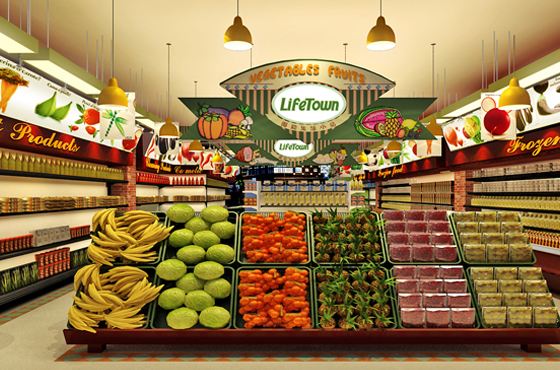The location of the fresh produce area in the fresh produce store has an important impact on the distribution of traffic in the fresh produce store. For fresh food in the end should save the dead corner or should be put into the mouth. There has been controversy.
Three voices have emerged to address this issue:
The first opinion is that fresh food should be placed in the entrance. The reason is that according to the shopping habits of customers, they usually buy fresh food first, then to meat and poultry, then to aquatic products and then to food and non-food areas. The store should design the category area according to customers’ shopping habits.
The second opinion is that fresh food should be put on the most negative side, and fresh food should be put on the deepest part of the active line. The reason is that fresh food is the category with the strongest ability to attract customers and the highest purchase frequency among all categories. Fresh food should be put at the end of the active line so that customers can pass through the whole area intact.
The third opinion is that fresh food should be placed in the middle section of the store. The reason is that fresh food is the most concentrated area in the store. The fresh food should be placed in the center of the store so that the fresh food traffic can radiate throughout the store.
★ In order to standardize the business and unify the layout ideas, reloading the old store store layout and new store opening, almost at different times the above three ideas were implemented once. But in some stores the implementation of the effect is not good, basically a huge flaw in the implementation of the site. Later, we learned a painful lesson and decided to sit down to properly sort out this is.
★ We have all been within the 6000 line as an example:
The first scenario of two-storey outlets, two-storey outlets one in and one out is naturally undesirable, leaving only one in and two out or two in and one out. But either way, it is certainly a full-field mandatory moving line. Customers must walk through two floors before they can buy a bill. Assuming one in and two out, we divide the store into four zones ABCD, A zone entrance, B zone on the second floor, C zone into the second floor, D zone out of the cashier line. Then fresh food should be placed in which area? The first we exclude the A zone. If the customer buys a large proportion of fresh food, it is very easy to see the cashier line by walking a long way from the end of the shopping, which is not very suitable for the B zone. Fresh food in the B area customers are very easy to ignore the A area straight to the fresh food, so that this originally prime location into chicken ribs. d area near the cashier is obviously not suitable. That leaves the C area. If the daily food, grain and oil on the first floor, fresh food on the second floor far from the cashier’s direction. The hot spots can be evenly distributed between the two layers. After buying fresh food, it is not far to go to that area, and you can return to that area quickly to choose anything you missed on the first floor. From the fresh food through the rest food and department to reach the cashier, can also increase a lot of random purchase behavior.
The second scenario is the first floor of the store, with a mandatory U-shaped line. The first floor U-shaped line is generally short and can be completed in a very short time, so fresh food can be placed at the entrance. Because fresh food is inevitably a priority for customers to buy. Customers who have finished buying food have extra time to stroll slowly along the active line to complete the whole store, and customers who are short of time can also use a shorter time to reach the checkout line. The layout of the category is basically the same as that of the U-shaped moving line.
The third scene is the first floor of the store, non-compulsory U-shaped dynamic line. That is, the entrance has a shortcut directly to the cashier line. The store is basically in the shape of a field. If we divide the field into ABCD four areas, A, D are the entrance and exit, B, C are in the bottom area of the U-shaped, fresh food should be placed in which area? Naturally, we want customers to walk through the whole store according to ABCD, and it is very easy to form dead ends in BC. This shape should not only put the fresh food in one area of BC, but also put the daily food or grain in another area of BC. This is to avoid a large shadow area in the store.
“The dynamic line of the store changes with the structure of the building. But basically can not jump out of a word, U word, 7 word, and field shape four basic features. The big taboo of fresh food store layout is not to divide the fresh food into two areas to stretch the dynamic line, the result is that the dynamic line is not elongated, the fresh food itself into no category aggregation of embarrassment, so that the overall customer flow declined.
Store layout is not the only way to improve sales. You embroider it into a flower, but it can’t replace the commodity power itself.
Post time: Apr-27-2023








